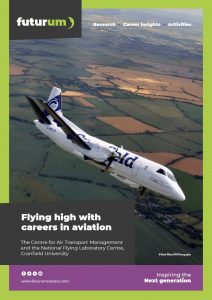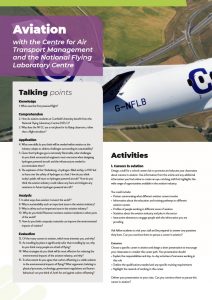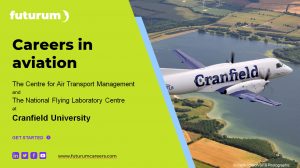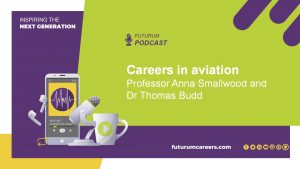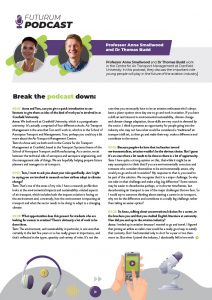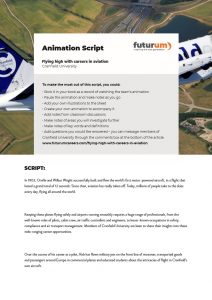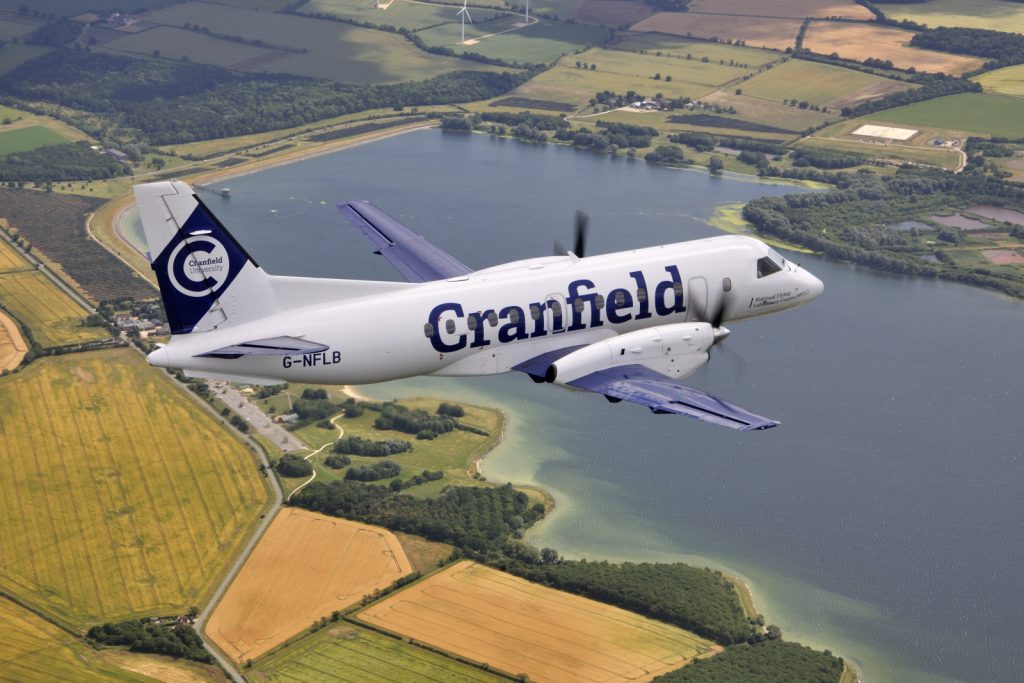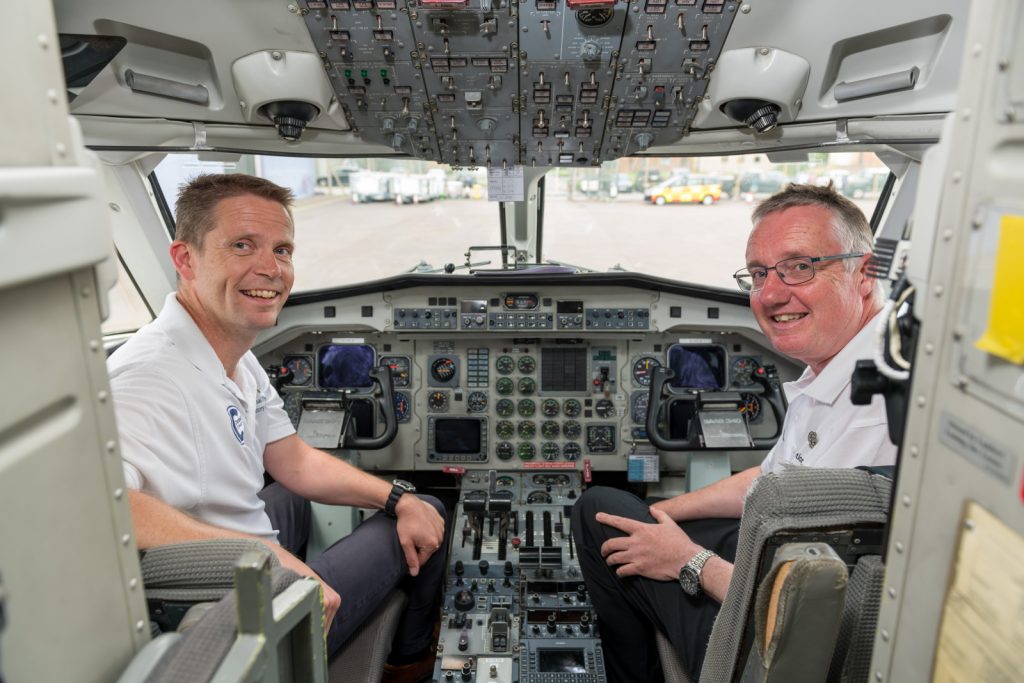Flying high with careers in aviation
When it comes to careers in aviation, the sky is the limit! Five professionals at Cranfield University’s Centre for Air Transport Management and the National Flying Laboratory Centre in the UK explain the breadth of possible careers in the aviation industry and discuss how the industry is adapting to modern challenges.
Talk like a member of the aviation industry
Aerodynamics — the study of interactions between air and solid bodies moving through it
Aviation — the flying or operating of aircraft
Carbon offsetting — compensating for carbon dioxide emissions by funding schemes that reduce atmospheric carbon dioxide
Composite material — a material made by combining several materials with different properties
Flight dynamics — the study of an aircraft’s performance and stability during flight
G-force — the force felt during acceleration
Glider — an aircraft that does not have an engine
Lift and drag — forces that act on an aircraft as it flies. Lift is the upwards force generated as air flows over a wing, while drag is the force that opposes the aircraft
Stall — when lift is reduced so an aircraft no longer experiences the upward force needed to keep it airborne
Zero-emissions fuels — fuels that do not produce carbon dioxide
From the well-known roles of pilots, cabin crew and engineers, to lesser-known occupations in safety, compliance and air transport management, careers in the vast field of aviation are diverse, interesting and exciting. Careers in aviation require rigorous professionalism, as many roles impact people’s safety, as well as a curious mind, as the field is constantly evolving to address modern-day challenges.
Members of the Centre for Air Transport Management and the National Flying Laboratory Centre (NFLC) at Cranfield University are keen to share their insights into the joys of these wide-ranging career opportunities. As Rob Harrison, Head of the NFLC, says, “Aviation remains one of the most exciting career options out there for young people!”
Flying high
Over the course of his career as a pilot, Rob has flown military jets on the front line of warzones, transported goods and passengers around Europe in commercial planes, and educated students about the intricacies of flight in the NFLC’s aircraft. “A career as a pilot offers huge variety,” he says. With good salaries, options for career progression and great opportunities to travel the world, being a pilot can be an illustrious career.
As well as having a deep understanding of the technical complexities of the aircraft they are flying, a pilot needs to understand weather systems, as environmental conditions can have a significant impact on the ability of a plane to fly safely and comfortably. Pilots also need to be quick thinking, analytical and calm. Being able to constantly assess situations, and respond accordingly, is essential. “Having a Plan B is crucial when you’re a pilot,” says Rob. “If something goes wrong, you can’t just stop and get out!”
Building planes
In 1903, Orville and Wilbur Wright flew a plane for a grand total of 12 seconds, covering a distance of less than 55 metres. While this achievement does not sound impressive today, when huge ‘jumbo jets’ fly hundreds of people thousands of kilometres around the world (at over 15,000 km, the world’s longest non-stop flight is from New York to Singapore), the Wright brothers’ accomplishment marks the most important milestone in the history of aviation – the day humans first took to the skies in a motor-powered aircraft.
“I love to remember that the Wright brothers not only flew the first powered aircraft, but they also designed and built it from scratch, including components such as the propellers and engine,” says Rob. “To test their designs, they even built their own wind tunnel!” Not only were the Wright brothers the world’s first pilots, they were also some of the first aeronautical engineers.
Aeronautical engineers are responsible for designing, developing and testing all aspects of an aircraft, which, in modern planes, involves everything from the electronics in the navigation system to the turbines in the engines, plus the aircraft as a whole.
Aeronautical engineers also design other flying devices, such as helicopters, uncrewed aerial vehicles (UAVs, also known as drones) and gliders. Other fields of engineering also contribute to the technological advances in aviation. For example, Rob’s colleague, Dr Simon Place, is a mechanical engineer with a background in flight dynamics who specialises in air transport engineering, aircraft systems and aviation safety. With an engineering career in aviation, you could find yourself studying the aerodynamics of aircraft wings using wind tunnel experiments and computer simulations or testing new composite materials to build more efficient aircraft.
Working together in the air and on the ground
While visible roles at airports and on aircraft include check-in agents, baggage handlers, pilots and cabin crew, the aviation industry is supported by a huge diversity of behind-the-scenes workers. From air traffic controllers (who schedule when planes can take off and land) to technicians (who maintain the aircraft) to fleet managers (who oversee the operations of an airline’s entire fleet of aircraft), it takes many different people to keep airports, airlines and aircraft operating smoothly, safely and efficiently. “The aviation industry succeeds because it has amazing people who, working together in a complex and safety-critical environment, each play an essential part in making air transport possible,” explains Professor Anna Smallwood, who has previously spent many years managing the aircraft fleets and airline operations for Thomson Airways and TUI Airlines and is now Head of Cranfield University’s Centre for Air Transport Management. “A career in air transport can provide opportunities to experience different roles, creating a breadth of knowledge and understanding that helps further a career in management and executive leadership.”
Staying safe
The aviation industry has an enviable track record when it comes to safety. Your chance of being in a fatal plane crash is 1 in 11 million. In contrast, your chance of being in a fatal car crash is 1 in 5,000. Safety is a top priority in aviation and is taken very seriously. After all, carrying hundreds of people over 9 km above the Earth’s surface in a metal contraption is no small endeavour.
Every part of the aviation industry includes roles specialising in safety to ensure that every aspect of flying is as risk-free as possible. Rhiannon Daye is the NFLC’s Aviation Safety and Compliance Manager, a role that includes monitoring the safety of the NFLC’s flights and keeping an eye on aviation incidents around the world. This involves investigating any issues around aircraft safety, finding out how and why aviation incidents occurred and proactively analysing data to identify potential hazards before they become a safety concern. “Once we have this information, we can take measures to reduce the likelihood of an incident happening,” Rhiannon explains. “These measures can include training, communication, devising new procedures or even changing physical structures.” In addition, Rhiannon runs the NFLC’s compliance monitoring system to ensure the NFLC is always following aviation laws and staying up to date with regulations.
Protecting the planet
The aviation industry is infamous for its contribution to climate change. “If aviation was a country, its carbon dioxide emissions would be the same as those of Japan,” says Dr Thomas Budd, who specialises in aviation sustainability. “The pressing need to reduce aviation’s environmental impact is an important issue for the sector.” As a result, virtually every role in the industry now includes aspects aimed at improving sustainability, as everyone working in the sector has a duty to contribute towards making aviation more environmentally friendly.
The number of careers specifically focused on aviation sustainability is also rising, with roles in airport and airline management, aircraft manufacture, industry and government regulatory bodies, and specialist consultancies. “For example, many airports now employ carbon strategy managers, who monitor carbon dioxide emissions from the airport and devise strategies to reduce these,” says Thomas, “while airlines employ sustainability managers who address a range of environmental impacts, including carbon dioxide emissions, noise pollution and waste management.”
In addition, the aviation industry needs people to design and implement the technological advances that will reduce the sector’s negative environmental impacts. “For example, in recent years, there has been a lot of interest in potential zero-emissions fuels, such as hydrogen, to power planes,” says Thomas. However, adopting new ‘clean’ fuels will require a lot of changes in the aviation industry, including the design and operation of aircraft and the methods used to handle and refuel them at airports. “People working in this aspect of the industry will require new skills to develop these new technologies and ensure they are used efficiently and safely,” says Thomas. “Because there is currently such a focus on aviation sustainability, it’s a really exciting time to be thinking about a career in this sector!”
The future of aviation
Climate change presents a massive challenge for the aviation industry, but not an insurmountable one. It takes a lot of fuel to get planes airborne, hence the industry’s large carbon footprint, and solving this issue requires new ideas and new technologies. Not only do aircraft and related infrastructure need to become more efficient, they also need to have their designs overhauled, and the public needs to accept these changes. As Rob explains, the industry is tackling this challenge head-on. “In the last ten years, we’ve seen the rapid development of fuel-efficient engines, sustainable aviation fuel and composite materials to increase the efficiency of aircraft design,” he says. “In the next ten years, I foresee the development of viable electric and hydrogen powered aircraft.”
Reference
https://doi.org/10.33424/FUTURUM435
© Cranfield University
© Graham Braithwaite
© Cranfield University
Cranfield University, the Centre for Air Transport Management and the NFLC aim to be at the forefront of these advances. Researchers are working on technological and engineering developments, as well as studying the important but less tangible aspect of passenger perceptions and experiences of flight. The team is confident that the aviation industry has a bright future and encourage you to join them in it!

The Centre for Air Transport Management: www.cranfield.ac.uk/centres/centre-for-air-transport-management
The National Flying Laboratory Centre: www.cranfield.ac.uk/centres/national-flying-laboratory-centre
Cranfield University, UK
Pathway from school to aviation
• “There is no pre-prescribed route to aviation,” says Thomas. With such a wide range of careers in aviation, you can follow any path that suits your interests and direct it towards your desired career.
• “Focus on STEM subjects if you are interested in the more technical aspects of aviation,” advises Rob. “Maths and physics are particularly useful if you hope to become a pilot or engineer.”
• However, the skills and knowledge you gain from other subjects can also be applied to careers in aviation. For example, geography will teach you about weather systems, which is important for pilots, and foreign languages will open overseas travel opportunities for pilots and cabin crew. In psychology you will learn about human behaviour which will help you understand the human factors in aviation safety, and English will improve your communication skills.
• Your choice of university degree will depend on your target career. If you want to design and build aircraft, consider a degree in aeronautical, aerospace, mechanical or electrical engineering. A psychology degree could be useful if you want to work in aviation safety and compliance. Careers in air transport management would benefit from a degree in business or management.
• There is no set degree for becoming a pilot, but you will need to undertake theoretical training and clock up many hours of flying before you qualify for a pilot licence.
• Cranfield University (www.cranfield.ac.uk) is a postgraduate university that offers courses in a wide range of aviation-related topics, from airport planning and aerospace dynamics to aircraft engineering and aviation safety.
• If you want to learn on the job, without attending university, look for apprenticeships in the aviation industry with companies such as Airbus, BAE Systems, Marshall Aerospace, Rolls-Royce, British Airways and the RAF.
The team’s top tips for getting started on a career in aviation
• “Join your local air cadet squadron, even if you’re not interested in a military career,” advises Rob. “You will be with other aviation-minded young people and have access to flying opportunities that do not exist elsewhere.” In the UK, you can gain flight experience and pilot training as a Royal Air Force (RAF) Air Cadet (www.raf.mod.uk/aircadets).
• Stay up to date with developments in the aviation industry with websites such as Aviation Weekly (www.aviationweek.com) and Simple Flying (www.simpleflying.com).
• The International Air Transport Association (www.iata.org) and the Airports Council International (www.aci.aero) host free webinars and release interesting reports about different topics relating to air transport.
• “It’s never too early to start growing your network,” says Thomas. “Do some research to find people who work in the aviation industry, and don’t be afraid to reach out to them and ask questions about their career. LinkedIn is a great place to do this.”
• “Attend relevant careers fairs,” advises Rhiannon, who found an internship through a fair organised by the Royal Aeronautical Society (www.aerosociety.com/careers-education).
About the National Flying Laboratory Centre
“Cranfield University is a unique place to study,” says Thomas. “We are the only university in Europe to own and operate our own airport, aircraft and air traffic control.” As such, Cranfield attracts students and staff from around the world, forming a vibrant community of people enthusiastic about everything related to aviation. The university is a globally recognised leader in the field of aviation and aerospace engineering, and it has strong collaborative links with the aviation industry, meaning students have access to a network of useful contacts and opportunities for future employment.
A classroom in the sky
The figurehead of the NFLC is its ‘flying classroom’, a modified aircraft that allows up to 24 students at a time to learn about flight while experiencing it for themselves. During a lesson in the flying classroom, students can access real-time flight data (including aircraft aerodynamics, engine performance and navigation) through tablet screens mounted on the back of each seat.
“Students can observe and record performance data, while at the same time feeling and seeing the actual movement of the aircraft as it flies, making for a unique learning experience,” says Rob, one of the flying classroom’s pilots. “Lessons in the flying classroom allow students to experience the lift and drag characteristics of the aircraft, its stability during manoeuvres and the effectiveness of the controls. Sometimes, we demonstrate how the aircraft’s stall prevention system works.” Unlike in a flight simulator, the flying classroom operates in a real-world environment, exposing students to the real interactions of an aircraft.
After the flight, students return to a classroom on the ground to analyse the data and the results of any experiments. “We conduct flight experiments so students can carry out in-depth research projects,” explains Simon, a demonstrator for the flying classroom. “The flight data are used for a host of different research topics, including alternative fuels and sustainable aviation.”
Experiencing flight in action
In addition to the flying classroom, the NFLC has two light aircraft, each of which can accommodate one student plus a pilot. “These aerobatic aircraft provide students with a much more sensory experience of flight, rather than the data gathering exercises in the flying classroom,” explains Rob. The light aircraft conduct specific flights to support the learning of students on different aviation-related courses at Cranfield.
For example, students studying flight dynamics or aircraft design take a flight that focuses on aircraft stability and performance, while students studying space engineering have the opportunity to experience the effects of microgravity and increased g-forces, and students studying aviation safety fly in the light aircraft to understand the impacts of spatial disorientation during flight.
“Each flight lasts about an hour,” explains Rob. “Before the flight, I carry out preflight aircraft checks, assess the weather conditions (we avoid flying through clouds as we want students to enjoy the view) and brief the student. During the flight, I demonstrate how the aircraft is controlled and how it performs in flight. If the weather (and the student’s stomach) permit, I also perform some aerobatic manoeuvres. It is incredibly satisfying to see the smiles on students’ faces when we land!”
Meet the team
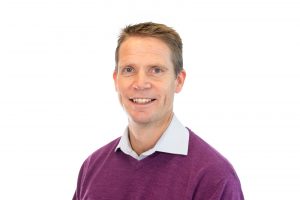
Rob Harrison
Head of the NFLC and pilot for the NFLC flying classroom and light aircraft
I flew a plane for the first time when I was 14 years old. I’ve always wanted to be a pilot, and I’ve always been fascinated with the idea of flight, so, aged 13, I joined the Royal Air Force (RAF) Air Cadets. I really enjoyed my time in the Cadets, and it allowed me to achieve my dream of becoming a fighter pilot.
I studied astrophysics at university and spent as much time as possible flying with the University Air Squadron. After graduation, I returned to the RAF. I flew the Tucano aircraft as a flight instructor and display pilot, then the Jaguar aircraft as a military pilot on the front line. Highlights of my time in the RAF include flying low-level aerobatics and completing incredibly complex operational missions. It was a privilege to be surrounded by colleagues who were so experienced and motivated.
After leaving the RAF, I gained my commercial pilot licence and worked as a business jet pilot for ten years. This allowed me to travel from the Arctic Circle to North Africa and from beaches to high up in the Alps. Sometimes, I’d visit five different countries in a single day.
Being a pilot gives me a sense of freedom that is difficult to replicate through anything else. The job is always a challenge, and there is a constant need to train and prepare. Every flight is different and there is always something to learn, so it’s never boring.
As a pilot at the NFLC, I love seeing our students enjoying flying. It’s true that some students do suffer from airsickness during their flight, but even they will smile once we’ve landed!

Rhiannon Daye
Aviation Safety and Compliance Manager
In January 2009, US Airways Flight 1549 lost all engine power and landed on the Hudson River in Manhattan, New York. Miraculously, everyone survived. I remember watching it on the news and wondering what led to such success in an emergency situation. This sparked an interest in aviation accidents and how to prevent them.
While studying psychology at university, I had an assignment to apply psychology to a real-world event. I chose the ‘Miracle on the Hudson’, which introduced me to the field of human factors and led me to a master’s in safety and human factors in aviation at Cranfield University.
After graduating, I struggled to find a suitable job and ended up working as an elf over the Christmas period! I attended aviation careers fairs and was offered an internship at Monarch Aircraft Engineering Ltd. From this, I carved out a role as a safety analyst, comparing the company’s safety data against official safety performance indicators. Unfortunately, I was made redundant when Monarch went into administration.
I have felt ‘lost’ at several points during my career, but it has always worked out in the end. At the time, it can be hard to see the light, but the right opportunity will come your way. Even when it feels like you’re taking a step backwards, you will learn new things. For example, working as a Christmas elf taught me how to conduct risk assessments on the spot, which is a skill I still use today.
I enjoy working in aviation safety because I like being able to make a difference, even in a small way. It’s interesting to find out why people do what they do, and to come up with ways to make sure that things are done safely.
Almost everything on an aircraft is designed with safety in mind, from the lights in the aisle to the overhead storage. So, next time you are annoyed about your carry-on luggage being the wrong size, remember that the limits are for your safety!
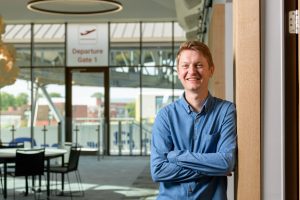
Dr Thomas Budd
Senior Lecturer and Digital Aviation Research and Technology Centre (DARTeC) Fellow in Airport Planning and Management
I was not always sure that I wanted a career in aviation. However, my older sister, who is also an academic in air transport management, inspired me to follow this path. She has always been passionate about aviation and her enthusiasm was infectious. I’m glad I listened to her!
At school, I was fascinated by the environment and climate change. I studied physical geography at university, which gave me a good understanding of the Earth’s natural processes and how human activity is affecting this balance. For my dissertation, I chose to investigate carbon offsetting, where people ‘offset’ their carbon dioxide emissions by paying for services that reduce carbon dioxide in the atmosphere. This set me on the path to working in aviation sustainability.
My role at Cranfield has three main parts. I teach students, giving lectures, running workshops and supervising them doing individual research projects. I also collaborate with other academics and industry partners to conduct research into aviation sustainability. Currently, we are investigating whether hydrogen could be used as a zero-emissions aviation fuel. Finally, I am sometimes commissioned to consult for private clients on a particular topic.
Climate change is the defining challenge facing society, and aviation has a crucial role to play in this. Once carbon dioxide is emitted, it stays in our atmosphere for 300-1,000 years. This means that the impacts of the carbon dioxide emissions of the past few decades will be felt by generations long after we’re gone. It’s not yet too late to change things, but we need to act now. My job allows me to be part of the solution.

Dr Simon Place
Senior Lecturer in Aviation Safety and NFLC Demonstrator
I have always had a passion for aviation. My father and grandfather both served in the RAF, and my secondary school was right next to the airport on the Isle of Man. I’m sure both these factors rubbed off on me!
At school, I enjoyed sciences and languages, and I studied engineering at university. I have worked in a variety of aviation related jobs over the years. I was an engineer in the RAF, where I was responsible for ground radar and communications, a software engineer at an aerospace company, and I spent three years studying helicopter gearboxes for my PhD. I am glad to say that I use the knowledge and experience gained from my previous roles in my current job at Cranfield.
I applied, unsuccessfully, for a job as a demonstrator on the flying classroom in 1996. Years later, the position became vacant again, and I was appointed in 2020. So remember – never give up!
Being a demonstrator in the flying classroom is amazing. I work as a member of the flight crew while teaching students during their flight. I don’t know anywhere else in the world where I could teach flight control theory while airborne!
Aviation connects the world and has resulted in improved communication. From a technical perspective, many innovations that we take for granted (such as GPS and radar) were developed for applications in aviation.

Professor Anna Smallwood
Head of the Centre for Air Transport Management
I was inspired to pursue a career in aviation when, as a teenager, I went to an airport for the first time. Having grown up in a small Yorkshire village, I looked up at the large departures board and realised that there was a big world out there to be explored. A friend who was a pilot encouraged me to follow my dream and apply for jobs in the industry, and I have never looked back!
At school, I loved English literature because books had the power to transport me to other societies and cultures and allowed me to travel in my mind. I also enjoyed economics, and almost went to university to study economics as I knew it would be helpful for a business career in the aviation industry. At the last minute, I changed my mind and got a degree in English literature and language.
The biggest highlight of my career was taking delivery of the first Boeing 787 Dreamliner aircraft into the Thomson Airways Fleet. This was the culmination of many months of hard work that involved examining every aspect of operating the aircraft, from studying its performance and safety to determining its engineering and maintenance requirements, as well as training crew and preparing IT systems and ground service equipment and personnel to be ready to deal with this new type of aircraft. The first time the Dreamliner took off with holidaymakers on board was a very special day.
Aircraft are incredible feats of engineering and technology that allow us to connect across countries and continents. I feel a sense of wonder every time I stop to think about this. I also love the fact that aircraft designs are often inspired by nature. For example, the Airbus wingtips were inspired by the dorsal fins of sharks!
Do you have a question for the team?
Write it in the comments box below and the team will get back to you. (Remember, researchers are very busy people, so you may have to wait a few days.)

